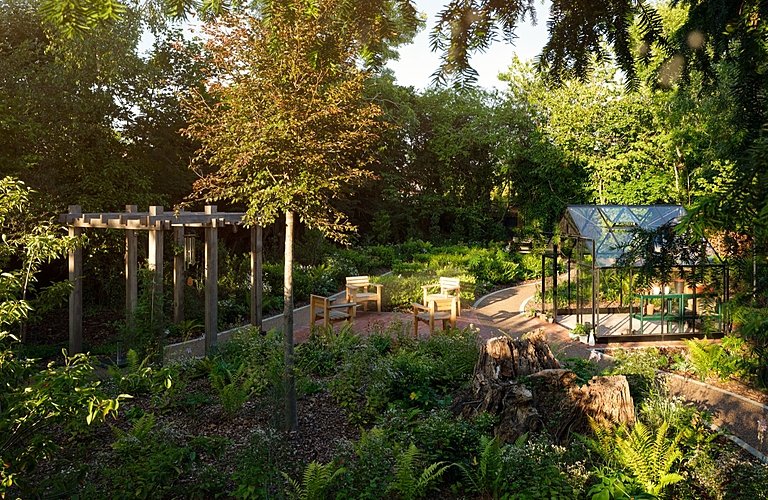192 Sloane Street, London SW1X 9QX

Sensory Gardens: Designing Outdoor Spaces for Dementia Care
Gardens have long been regarded as sanctuaries of peace and rejuvenation, but in recent years, their role in healthcare, particularly in dementia care, has garnered significant attention. Designing sensory gardens has emerged as a thoughtful approach to enriching the lives of individuals living with dementia, offering a holistic space that nurtures physical, emotional, and cognitive wellbeing.
KYN has been at the forefront of this movement, designing gardens as vital components of care. Andy Pringle, associate landscape architect at LUC, an award-winning environmental consultancy, emphasises the pivotal role gardens play in the wellbeing of residents. In this blog, Andy generously shares his expertise in designing sensory gardens at KYN and offers invaluable advice for creating your own green space.
The Layout: Central to the design philosophy is the layout, which prioritises safety, ease of navigation, and comfort. Clear pathways, varied routes, and ample seating ensure residents can freely explore and engage with their surroundings. The selection of plants and features aims to evoke sensory experiences that stimulate memory, reduce anxiety, and foster a tranquil ambience.
Choice of Plants: The selection of plants is crucial in engaging sight, smell, and touch. Andy Pringle advocates for diverse flora, from visually striking specimens like Angelica archangelica and Cynara cardunculus to fragrant herbs like Chamaemelum nobile and Thymus serpyllum. These plants captivate the senses and serve as catalysts for reminiscence and relaxation.
- Eye-Catching Plants: Stimulate the senses with diverse plant colours, shapes, sizes, textures, and patterns. Opt for bold and vibrant flowers such as purple coneflowers, pelargoniums, tulips, and alliums to captivate visual attention. For a more calming effect, consider softer planting schemes, particularly in blues and whites. Lavender's floral scent has been shown to decrease anxiety, while jasmine's soothing aroma promotes peace. Winter jasmine, with its cheery yellow flowers, adds a splash of colour during colder months, uplifting spirits and brightening landscapes. Incorporating these plants not only adds visual interest but also contributes to a serene and inviting atmosphere in your sensory garden.
- Scented Plants: Freshly cut grass, earthy aromas, and floral fragrances are just a few garden scents that stimulate the olfactory senses. Enhance the sensory experience with a mix of aromatic plants, from the strong-scented roses and jasmine to calming lavender, refreshing mint, and savoury sage.
- Plants to Tempt Taste Buds: Add flavour to your garden with fresh herbs, vegetables, fruits, and edible flowers. From crisp carrots and juicy tomatoes to luscious apples, strawberries, and pears.
- Textured Plants for Touch: Encourage tactile exploration with a variety of textures in your garden. Soft, furry leaves like Lamb's ears and feathery foliage provide a gentle touch, while the smooth surfaces of succulents offer soothing sensations. Rough seedpods, tree bark, and spongy mosses offer exciting textures to explore. Incorporating smooth pebbles or rough natural stone boulders along pathways or around ponds adds further tactile interest.
Sounds: Incorporate features that encourage soothing sounds in your garden. Native wildflowers attract buzzing bees and other pollinators, creating a symphony of natural sounds. Trickling water from a waterfall or fountain provides a contrasting sound, adding to the auditory experience. Bird baths and feeders attract feathered friends, ensuring the sound of your garden changes throughout the day and seasons.
Accessibility: Accessibility is another key consideration in garden design, ensuring that residents of all mobility levels can participate fully. Raised planters accommodate wheelchair users, while strategically placed seating areas cater to those with impaired balance or coordination.
Ultimately, sensory gardens embody a holistic approach to dementia care, addressing the multifaceted needs of individuals while fostering a sense of connection with nature.

